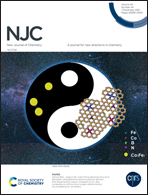The preparation of a special fluorescent probe with an aggregation-induced emission effect for detecting hydrazine in water†
Abstract
In this work, based on the N-phenyl carbazole fluorescent group, a new molecule named 2-(4-(9-phenyl-9H-carbazol-3-yl)benzylidene)-1H-indene-1,3(2H)-dione (PCBI) is firstly synthesized and used as a fluorescent probe for detecting N2H4 in aqueous solutions. The PCBI probe exhibits an excellent aggregation-induced emission (AIE) effect with a good fluorescence response to N2H4 in a DMF–H2O (fw = 90%) system. A fitting curve between the fluorescence intensity at 628 nm of probe and the concentration of N2H4 shows excellent linear in the range of 0–6 × 10−6 mol L−1. Meanwhile, the PCBI probe exhibits good sensitivity and selectivity. Based on the density functional theory, the sensing mechanism of this probe is attributed to a change of the molecular aggregation state and an induced charge transfer (ICT) effect from group conversion. The PCBI test strip can be applied successfully to detect N2H4 rapidly in water.



 Please wait while we load your content...
Please wait while we load your content...